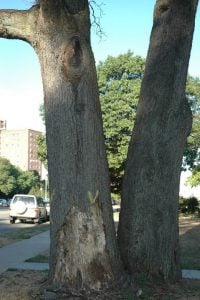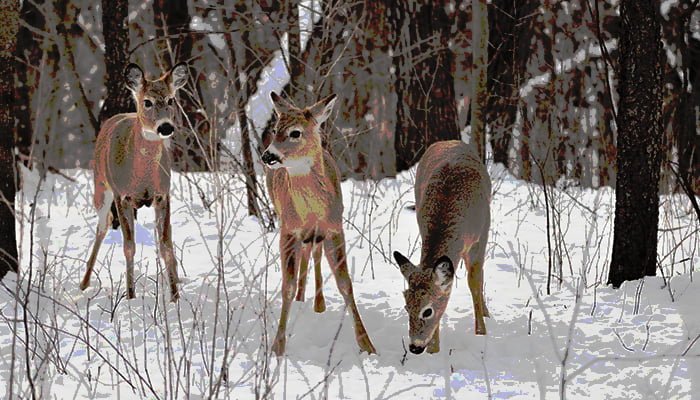While you may think frost, snow, ice and other harsh weather conditions of winter are the main cause of winter tree and shrub damage, it is actually deer! Winter deer damage can be extremely destructive to your plants and shrubs. On average, an adult deer can eat about 6 pounds of plants daily. Imagine 6 pounds of plants per deer – that’s a lot of plant feeding, especially in an area like mid and upstate NY where deer are so prevalent.
While deer feed all year long, winter deer damage is much worse, and here’s why. When fields, gardens, and backyard plants become dormant, and there is little to no food available, these deer will start feeding on anything they can find. This can lead to deer feeding on other food sources they don’t normally prefer like maples, ashes, grape vines, evergreens, etc. A winter following a summer drought is sure to be even more damaging to your landscape, because deer enter winter hungrier and more desperate.
In addition to harmful feeding, deer also can damage tree bark from antler rubbing, which can lead to other issues. The most popular time of year that deer do the most bark rubbing is in late fall and early winter. This is a territory marking technique used during mating season to show dominance. Antler rubbing will again intensify in late winter as a way to help bucks shed their antlers. So how does this damage a tree?
- It scrapes the surface of the xylem and removes the cambium at the base of the tree trunk.
- The xylem is what carries water and minerals to the leaves of the tree from its roots.
- Since water and minerals are scarce during winter, this added stress is particularly damaging.
- If enough damage is done to sever the tissue all the way around a tree, the tree will quickly starve due to a lack of food and minerals.
 So how can you protect your trees and shrubs from winter deer damage?
So how can you protect your trees and shrubs from winter deer damage?
- The best way to protect your trees from antler rubbing is to make it hard for a deer to get close to your trees. The best way to accomplish this is by putting up fencing.
- Fencing must be at least 6-8 feet tall to effectively keep deer out.
- Another barrier method to protect your tree’s bark is to wrap the trunk with chicken wire, or other available types of plastic tree trunk guard.
- For your shrubs, burlap coverings can go a long way in deterring deer from feeding on your shrubs. This netting and covering discourages the deer because it makes feeding much more challenging.
- Repellents are also a good defense against deer. Repellents typically refer to sprays, but some other forms of deer repellent include planting trees that they find unappealing (Black Locust, Boxwoods, Cedar, False Cypress, Ginkgo, Hackberry, Japanese Maple, Oak Trees, Magnolia Trees, and many more can be classified as “deer-resistant” trees), or using items with human scent on them to deter the deer.
- Removing food sources from your yard before winter (like bird feeders with corn, dried berries, or sunflower seeds) is very important, as this will quickly attract hungry deer.
Preparing your landscape for winter plays a vital role in determining your tree and shrub health come spring. Not only should you consider protection methods to help your trees and shrubs survive the hard and cold conditions of winter (like Wilt-Pruf), but also consider deer deterrent methods. Contact Red Cedar today for your free consultation, and let us help you prepare your backyard for winter and prevent destructive winter deer damage!


